In the dynamic realm of cryptocurrency and blockchain technology, smart contracts have emerged as a transformative and disruptive force. These ingenious digital agreements hold the potential to reshape not only how we conduct transactions but also how we interact within the vast and intricate ecosystem of crypto exchange platforms. This comprehensive guide will navigate through the intricacies of smart contracts, tracing their historical evolution, and diving deep into their myriad applications. By providing a fresh and comprehensive perspective on this groundbreaking technology, we aim to highlight its pivotal role in the world of blockchain and decentralized finance.
Unraveling the Essence of Smart Contracts
In its essence, it resembles a digital covenant forged between two parties, ensconced within intricate lines of computer code. These contracts find their exclusive abode within the blockchain, a realm that ensures their indomitable immutability, impervious to any attempts at tampering or alteration. Distinct from conventional contracts, smart ones adhere to a straightforward “if-then” principle, where pre-established actions unfurl automatically when certain, preordained conditions come into play.
Tracing the Evolution of Smart Contracts
The inception of the concept can be traced back to 1994 when Nick Szabo, a visionary cryptographer, first introduced the revolutionary idea of encoding traditional contracts into lines of computer code. Szabo envisaged a future where contracts would be self-executing, obviating the need for intermediaries such as banks and lawyers. However, at that juncture, the foundational technology for this vision, the blockchain, was still in its nascent stages of development.
A pivotal moment in the history occurred in 2009 with the advent of Bitcoin, the world’s first practical implementation of blockchain technology. Bitcoin laid the foundation for the decentralized nature of smart contracts. However, it wasn’t until 2015 that Ethereum, created by the visionary Vitalik Buterin, came into existence and introduced the world to functional smart contracts, thus breathing life into Szabo’s visionary concept.
Demystifying Smart Contract Functionality
The mechanics are best understood through real-world scenarios. Take, for instance, John’s desire to purchase Mike’s house. In a traditional transaction, a multitude of intermediaries such as banks, lawyers, and real estate agents would intervene, leading to exorbitant fees and time-consuming processes.
However, by employing a smart contract on the Ethereum blockchain, the agreement is distilled into a crystal-clear statement: “WHEN John pays Mike 300 Ether, THEN John will receive ownership of the house.” Once established, this smart contract becomes immutable, ensuring John’s security and peace of mind in the transaction. There are no third parties, no commissions, and no delays—just a seamless, trustless transaction.
This level of automation and trust is made possible by the underlying blockchain technology. The blockchain operates as a decentralized network of computers (nodes), devoid of single-entity control. This distributed nature ensures heightened security and near imperviousness to hacking attempts, safeguarding the integrity of smart contracts.
The Diverse Applications
Smart contracts transcend the realm of financial transactions; they find relevance across a myriad of industries, heralding efficiency, transparency, and security:
- Insurance Revolution: Within the insurance sector, they bring about a paradigm shift by simplifying complex and time-consuming claims processes. Compensation is automatically disbursed when predefined conditions, such as flight delays, are met. This innovation revolutionizes the landscape of insurance.
- Healthcare Empowerment: In the healthcare domain, where the security of patient data is of paramount concern, smart contracts, facilitate secure data transfers. Patients gain unprecedented control over their sensitive information, fostering trust in the healthcare system.
- Transparent Elections: Governments have the opportunity to embrace smart contracts to revolutionize voting systems. By ensuring transparency and integrity in elections, systems safeguard votes from all forms of fraud, laying the foundation for more reliable and trustworthy democratic processes.
- Efficient Business Operations: Enterprises can streamline their payroll processes with smart contracts, guaranteeing timely and error-free employee payments. This automation not only enhances efficiency but also reduces administrative overhead.
- Supply Chain Optimization: They offer an enticing solution for streamlining and fortifying supply chain processes. By automating various stages of the supply chain, they diminish reliance on intermediaries and augment overall security, making the movement of goods more efficient and transparent.
- Blockchain Fundraising: Entrepreneurs embarking on blockchain projects can turn to Initial Coin Offerings (ICOs) for funding. Smart contracts underpin these ICOs, ensuring transparent and equitable token distribution to investors. This innovation is reshaping the fundraising landscape in the digital age.
In summary, smart contracts are not confined to the financial realm; they serve as catalysts for transformation across diverse industries. Their capacity to enhance efficiency, transparency, and security positions them as pivotal instruments for shaping the future of digital transactions and agreements. With their continued evolution and integration into various sectors, they promise to revolutionize the way we engage with technology and conduct business on a global scale.
Creating Smart Contracts
Creation involves a series of key steps:
- Agreement: The parties involved define the terms and conditions of their agreement, specifying the triggers that will lead to contract execution.
- Code Development: The code is meticulously crafted to delineate the precise actions to be taken when conditions are met.
- Deployment: The completed smart contract is deployed onto the chosen blockchain, where it becomes an immutable and integral part of the ledger.
For individuals lacking coding expertise, user-friendly development platforms offer templates and intuitive drag-and-drop functionality, simplifying the process of contract creation.
Analyzing the Upsides and Downsides
Advantages
- Streamlined Efficiency: Smart contracts execute transactions with remarkable speed, resulting in a substantial reduction in processing time.
- Automated Precision: The elimination of intermediaries through smart contracts translates to reduced costs and simplification of complex processes.
- Precision and Reliability: Minimized human intervention ensures a high degree of precision and unwavering reliability in contract execution.
- Building Trust: The immutability and transparency cultivate trust among parties, bolstering their confidence in the agreement.
- Fortified Security: Smart contracts, safeguarded through encryption and stored on the blockchain, deliver an unprecedented level of security.
Drawbacks
- Immutability Dilemma: Once activated, smart contracts remain unalterable, which may restrict adaptability in certain specific scenarios.
- Coding Complexity: The creation of code demands a considerable level of technical expertise, potentially acting as an obstacle for those lacking such proficiency.
In summation, smart contracts herald a revolutionary shift within the crypto exchange platform, offering an exceptional blend of efficiency, transparency, and security. Their extensive and diverse applications across a multitude of industries position smart contracts as pivotal players in the future of digital agreements and transactions. As blockchain technology continues its evolution and refinement, the potential of smart contracts remains boundless, affirming their role as fundamental building blocks of the decentralized digital landscape. Embrace the future where the traditional “if-then” transforms into the immediate “right now, ” and the opportunities are genuinely limitless.



